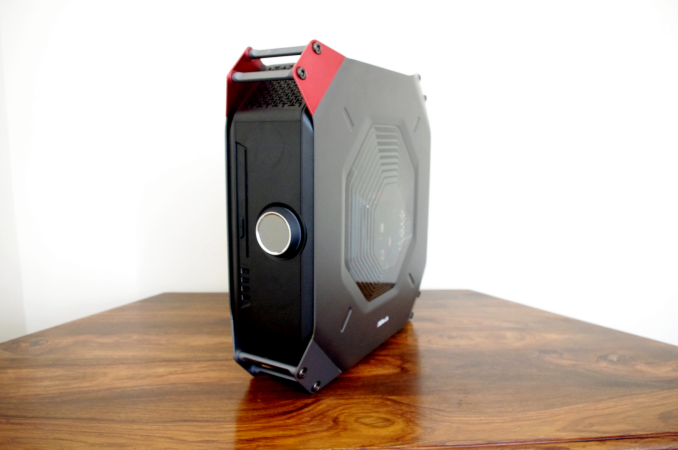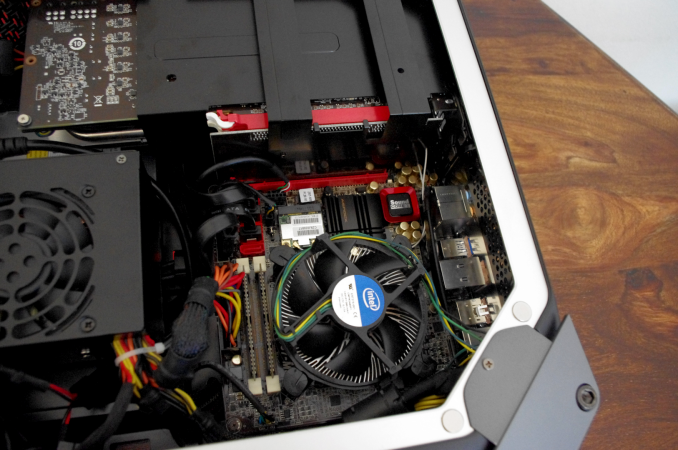ASRock M8 Barebones Review: My Steam Box
by Ian Cutress on January 2, 2014 10:00 AM EST- Posted in
- Barebones
- Intel
- ASRock
- Motherboards
- Cases/Cooling/PSUs
- Z87
ASRock M8 Conclusions: Recommended Steam Box Alternative
Small form factor systems that pack a punch is one of the ways this industry is moving forward. We only have to look at modern consoles and prebuilt systems like the Mac Pro to realize that people want everything smaller with no compromise in performance. Obviously going small means potential heat issues, and then everything centers on keeping the system cool, but also quiet. There is no point in having the world’s smallest computer and making it sound like a jet engine. Of course there are attempts underway to make the PC-you-play-next-to a thing of the past, with streaming from one device to another so heat and noise are no longer part of the equation (this means the realm of big boxes might come back). Nevertheless, there is and always will be a market for the box under the monitor/TV, and the ASRock M8 provides a small form factor system that can be as mobile as you like.
A lot of the buzz around the ASRock M8 will be the industrial design, and the fact that BMW’s design team had their inputs. I want to push that to one side, and take the system as it is – something elegant to look at that is easy to use and that provide sufficient power if a user wants to put the hardware together in order to do so. Using an 8-series platform means that small and large Haswell CPUs can take part, from the 15/25/35W parts all the way up to the full fat i7-4770K, although the 4-phase non-heatsinked solution might be cause for concern if a user wants to overclock. The 450W power supply is plenty for any GPU up to ASRock’s recommended 200W maximum, even though we topped out at ~250W at the wall under a GPU heavy load, meaning that I think that this PSU would handle 300W graphics cards – the only issue then would be heat removal.
In terms of air movement, the system allows a bottom to top air flow, giving the CPU cooling priority over the GPU. This could create issues if the system is placed standing up on a carpet, although the usual place for a console might be next to the TV providing the visuals on a TV stand, or this is the system that at a LAN would end up on the desk next to the gamer. The mobility is going to be one of the main draws of the ASRock M8 – the handles are built into the chassis and are sturdy enough to carry with one hand. Cases like the Bitfenix Prodigy are double the width and have flexible handles – the ASRock M8 solution is a step above this and even more so over handle solutions like the Lian Li TU-200/TU-100. The lock mechanism helps keep the magnetized side panels on, although using a generic lock system might not be the best thing for LAN events whereby some of the people at the event would have a similar locking device.
For hardware specifications, the front panel providing four USB 3.0 ports and a side loading ODD should be plenty, along with the fold out audio and card reader at the bottom. On the inside the motherboard has space for five storage devices whereas the case has room for four – this would allow a nice SSD boot drive and three storage 2.5” drives as necessary allowing the size of the case to not be a hindrance to storage. The motherboard comes with a dual band 2T2R 802.11ac WiFi module and Creative Sound Core3D which match the higher end for the M8 design (some users would point out that Core3D might not be ideal for them), and thankfully due to the nature of the case putting all the hardware in is actually very easy. The only issue I would like to point out is that the ODD color does not match the insides of the case, something which might want to be rectified. On the software side, ASRock bundle their usual BIOS/software combination along with a three month license of XSplit for game streaming. They missed out on an opportunity to do something unique on the M8 in this regard.
The price might remain as the final sticking point. $550 for what could be purchased for $350 (albeit a bit bigger and not as aesthetically pleasing perhaps) might seem a bit of an excessive jump, although I doubt $350 would get something this size and powerful. Take a look at the Tiki which Anand used as part of the GTX Titan release – it came on a granite base and cost a pretty penny. By comparison, the ASRock M8 is a good deal.
The best way to sum up the ASRock M8 is from the gift perspective: buying it will never put your machine on the top of the performance pile, but it does offer something different if you wanted to splash out on a case that remains mobile, or are building a system for a loved one and wanted an out-of-the-box solution that looks awesome.
I started this review mentioning Steam Box and then set about testing a $2000 solution, although removing some of the expensive items it could easily reduce down to sub-$1300 device that would play any Windows and Linux game with comparative ease. I tend to chop and change my PC a lot (I keep bouncing between small and super large every six to twelve months), but for my brother this would be perfect: he games, he goes to LANs, and he needs a bit of power. It would make a nice Christmas present for sure.
After all is said and done, the ASRock M8 is a very nicely built barebones that offers the opportunity to build a mobile gaming platform that should stand the test of time as well as providing nice aesthetics and industrial design. The price might not appeal to most in the bang-for-buck stakes, but ultimately that is not the real point of the M8 – power and size with design. For this, I would like to give the ASRock M8 an AnandTech Silver Award.
ASRock M8: AnandTech Editors’ Choice Silver Award
At AnandTech our rating system goes Platinum, Gold, Silver, and Recommended: Should ASRock release a future version with perhaps another couple of VRMs and a heatsink, it might have been considered for a higher award. I would very much look forward to an X79 platform (or Haswell-E) like this in the future. The main issue there would be heat removal, but I am sure some clever people might be able to figure that one out. Add in some Thunderbolt, Intel NICs, SATA Express – the list could go on to make the system future proof.














78 Comments
View All Comments
brucek2 - Friday, January 3, 2014 - link
Is the optical drive really DVD only (not Bluray?) If so that seems exactly wrong to me. I'd rather have either no optical drive at all and save the ~$70, or have one that can play Blurays.Death666Angel - Monday, January 6, 2014 - link
German website tweakpc.de says it is blu ray. But I have no idea how you get $70 for a slim DVD ODD. They retail for 20€ here.fuhgetaboutit - Friday, January 3, 2014 - link
Minor nit - article should use one space after a period, not two.http://channel9.msdn.com/Blogs/TheChannel9Team/Bil...
IanCutress - Friday, January 3, 2014 - link
Personal preference, was always taught to use two from the early days and it seems unnatural to my eyes to see only one. There are reams of articles, blogs and even societies and groups for each, just as there are the serial comma (which again I was taught to use, and leaving it out feels wrong), or that companies are plural entities, not singular. I always used double spacing for publishing to scientific journals, never heard a peep from their stylists.Johnmcl7 - Saturday, January 4, 2014 - link
I've always been taught to use two spaces after a full stop, one after a comma and still do partially because it's what I'm used to but I think it looks better as well.John
Gigaplex - Friday, January 3, 2014 - link
Why did they bother using the Z87 chipset? With that minimal power deliver and recommendation to avoid overclocking, it would have been cheaper to use the H87 chipset.theNiZer - Friday, January 3, 2014 - link
Ian Cutress - I am surprised that you seem to take heat and noise considerations so light, especially when many other reviews point out these weaknesses in the M8. And why did you not test these aspects more systematically in the review?IanCutress - Friday, January 3, 2014 - link
I didn't see any issues with heat - I stuck to ASRock's recommended power limit on the GPU and used a low powered 35W CPU rather than a full fat 4770K and overclocking. As for noise, the only equipment I own to measure noise are my android devices, which are not calibrated in any shape or form. Plus I live right next to a main road, so there is always noise of cars going past, affecting any reading. Suffice to say, it is audible at idle at 1 ft away, and does not particularly bother me at full load, but I may be biased by a large threshold due to my location.colonelclaw - Friday, January 3, 2014 - link
The key issue that Valve needs to convince the public about, with regards to Steam Boxes, is that the higher up front cost is considerably offset by the savings you will make on buying games from Steam, especially in tandem with the frequent Steam Sales, Daily Deals, Midweek Madness etc.The problem is that long-sightedness can be a bit of a hard concept for many. $500 for a console, versus maybe $800 for a Steam Box is a hard sell, even though we all know that 20 games at $60 dollars versus 20 games at $15-$20 is a no-brainer.
And that might even be a conservative analogy - I have over 150 games on Steam, at least a quarter of which are AAAs. Being a bit of a cheapskate, I only buy games on sale, yet I never have to wait long after release to do so. The added advantage of this is that if the release was buggy it is more likely to have been fixed by the time it goes on sale.
teldar - Friday, January 3, 2014 - link
You guys need an editor who knows the English language. Reading some of your stuff is brutal.